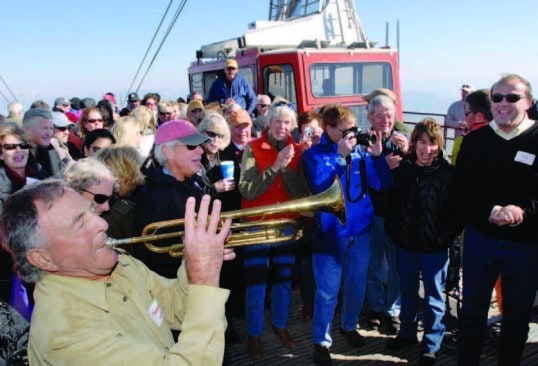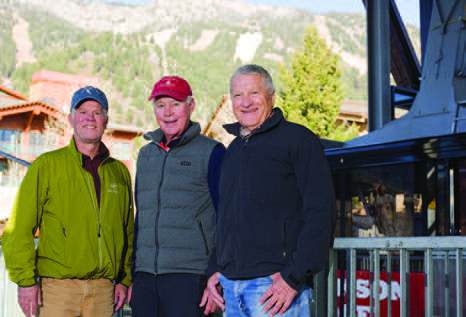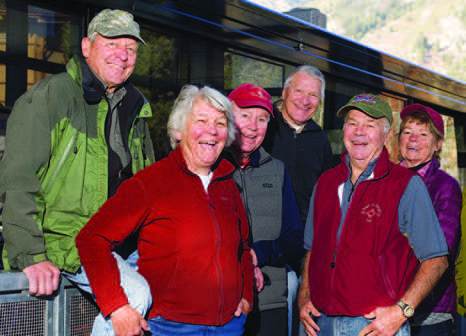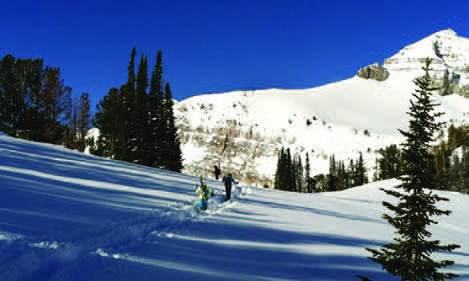Read The
Current Issue
Schools of Skiers
Yeah, the Jackson Hole Air Force is hardcore. But have you seen the seventy-somethings who shred Tower 3 Chute?
BY BRIELLE SCHAEFFER AND MAGGIE THEODORA

JACKSON HOLE MOUNTAIN Resort Mountain Sports School instructor and backcountry guide Jamie Mackintosh often brings her groups into Corbet’s Cabin, perched at 10,450 feet at the top of the tram. It’s a great place—protected from the extreme winds and temperatures and the sideways snow often raging that high—for a safety briefing before her skiers tackle some of the resort’s more advanced terrain. Open to the general public, it’s not just ski school and guided groups that take refuge in the cabin.
“I heard these hot-shot financial types from New York griping about all the old folks in the cabin,” says Mackintosh, who has been with the Mountain Sports School (MSS) for thirty-one years and has been a National Demo Team candidate twice. “Those old folks were with me, and I knew they could most likely outski this group talking trash.” Mackintosh told the New Yorkers to try and keep up when her “old folks” stepped into their skis. “We ski pretty hard,” Mackintosh says. “Every one of the ‘old folks’ the New Yorkers were complaining about is an expert skier.” The old folks ski Alta 1, Tower 3 Chute, and the Hobacks, all black diamond—or even double black diamond—runs.
Meet the Old Dogs, eighteen friends, pretty much all septuagenarians, who go out with three MSS instructors in groups of six every week from the first week of January through the end of the JHMR ski season in early April (excluding Presidents Day weekend). While the Old Dogs were the first group of its kind when they started eighteen years ago, today there are upwards of a dozen invite-only bands of locals averaging probably somewhere just upwards of sixty-five years old that ski with MSS instructors and guides on a weekly basis. The groups all have names. The Monday Marauders. The Tram Chicks. The OB-1s. The Old Dogs. The New Dogs. We’ve heard rumors of a group called the Hot Flashes. The Old Dogs even have a logo: a smiling bulldog. (They each have a vest with it on the back.)
“It’s been a slow, organic growth,” says Lexey Wauters, MSS assistant director. “There wasn’t any organized effort on our part to get these groups going. The Old Dogs started, and I think word just got out. Financially, it’s a great deal. I think that’s part of the reason, too.”
All groups are under the resort’s Passholder BYOGroup program. From the resort’s website: “Gather six friends, pick a day, and ski or ride with the same instructor (or team of instructors) for ten weeks starting in January. Explore the far reaches of the mountain and your ability, with your friends along for the ride. Bonus: BYOGroups score early Tram or Gondola access.” For the ten weeks, each group member pays $835. That breaks down to less than $100 per day, a full day with an instructor. Wauters hypothesizes these groups appeal to older skiers because of the time commitment. “I don’t know too many thirty- and forty-somethings that can take a full weekday off for ten weeks in a row to ski,” she says. “We can certainly accommodate younger groups if they’re out there.”

THE OLD DOGS first formed in 1996. At the beginning of that season, Jack Nunn, Al Upsher, Tom Glassberg, Stan Trachtenberg, Steve Hancock, and Salisbury Adams met in one of Pepi Stiegler’s race camps. Wanting to prolong the camaraderie and skill-building of the camp, they recruited instructor/guide Nato Emerson to ski with them once a week for the rest of the season. “It just started as a Wednesday group that skied together with instructors,” says Bill Maloney, a seventy-seven-year-old Old Dog who skis 140 days a year. “Most of the instructors that we have in the Old Dogs have been with us a long time. They’re all top-of-the-line instructors.” Over the years, the group grew and required more instructors. Karen Valenstein became the first female member in 1998. Today there are about a half-dozen female Old Dogs. (Out of the 130-some combined skiers in all the groups, Wauters guesstimates that about 45 percent are women.)
It’s not unusual for groups to grow out of larger JHMR camps. “AJ Cargill and I took turns teaching a group of women that came out of our old Women Who Rip camp,” Wauters says. “They had such a blast in the camp, they wanted to keep it going.” Wauters remembers that group started around 2000. “It’s still around,” she says. “It has morphed—some originals have left and new women have come in. Coaches have changed. I think most groups evolve over time.”
Even though groups morph, with members coming and going, there are often waiting lists. “When I moved to Jackson, I knew there were all of these local groups, but many were full. You couldn’t just come into town and join the Old Dogs or New Dogs,” says Nancy Leon, a sixty-year-old, semiretired former vice president of a number of Internet startups who moved here six years ago and skis about eighty days a year at the resort and another twenty-some in the backcountry. “You come to a community and you want to belong. You want to get connected and be with people who are good skiers. I subbed into groups for a year and then decided that rather than waiting to be invited to join a group, I’d start my own.” Leon did something with her group that no prior group had done. “I didn’t want a group that skied in-bounds,” she says. “I wanted to go out of bounds.”

Leon enlisted the help of Bruce Keller, one of several MSS instructors who doubles as a JHMR backcountry ski guide, and wrangled together some friends. The OB-1s were born. Because JHMR has a limited number of backcountry permits for the season, it was decided the group got to head out of bounds five of its ten weeks. “We’re all knowledgeable about the in-bounds terrain,” says Leon, who lived and skied in Chamonix for three years after college and is a JHMR ski host. “We’re less familiar with the out-of-bounds areas,
and we also want to make sure we ski them safely. We have a very challenging snowpack sometimes, and, particularly with your friends, you don’t want the responsibility of taking them to places where there is a risk of avalanches. When we go with a guide, we’re being as safe as we can be.”
BYOGROUPS each have their own objective. “Some are more socially minded and others have very specific technical objectives,” says Brian Maguire, MSS director. The OB-1s focus on skiing the resort’s sidecountry. There’s a group of master racers. “A couples’ group is a new one that came up this winter,” Maguire says. The Monday Marauders, a twelve-skier group (split into two groups of six) was started five years ago. Maloney is in that group in addition to the Old Dogs. The Marauders are similar in age to the Old Dogs but like to ski a little faster. (Until recently, the Marauders included eighty-seven-year-old Pierre Maréchal. But he “dropped out because we’re a little too fast for him,” says Maloney. “He still skis hard, though.” Maréchal has since established a group of advanced skiers that are all in their eighties.)
The Old Dogs are focused on improving. “We want to get technically better every year,” Maloney says. And members do. “Everyone in our group gets better every year,” he says. “You don’t have to take a big jump if you improve incrementally every year. By getting better it makes it easier on the body, too.” Sarah Carpenter, who sometimes subs in as the OB-1s’ guide, says, “It’s great to see the groups of people who are really excited about learning and improving.” Linda Brooks, seventy-four and a member of the Old Dogs and the Tram Chicks for over a decade, says, “The instructors for both of my groups are informativeand helpful. With their help, I’ve learned how to ski the harder slopes.”
The OB-1s, who range in age from fifty-eight to their mid-sixties, want to go to places they’re not comfortable going on their own. Two years ago, Keller took the group up Cody Peak and to No Shadows, which none of them had skied before. The difficulty of No Shadows is substantial: between 35 and 45 degrees steep with a committing, cornice-y entrance. But it was the ascent—up a knife-edge, icy ridge in their ski boots with their skis strapped to their packs—that was the bigger test for the group. “We all thought we’d fall off at some point,” Leon jokes. “The ascent was an adrenaline rush because you’re climbing up there in your slippery ski boots with just your ski poles for balance. It’s a sheer edge, and it’s icy, and you’re just like, ‘get me up there.’ ” The group made it to the top safely; not a single member stumbled, much less fell off.
“Of course after we did that, we did have to think about the down,” Leon says. “We’re up on this huge face where there have been avalanches that have killed people.” That day, the group found perfect snow, though. “We did No Shadows and had so much confidence that we went and did Spacewalk,” Leon says. “Or maybe it was Zero G.” Either run is a notorious out-of-bounds test piece just south of Rendezvous Bowl. Both have pitches even steeper than that of No Shadows and middle sections no more than fifteen feet wide. “That was pretty amazing,” Leon says. “Everyone is on this high. There’s this real shared experience being happy for your friends, happy for yourself, and happy to be sharing something so special. Everybody likes to connect and belong to something.”

“I THINK FOR every group, it is as much about the social piece of it as it is about the skiing and getting better,” Wauters says. About his two ski groups, Maloney says, “They’re great people, all enthusiastic skiers. It’s a social event every single day we ski together. They’re great friends, and it’s wonderful at our age that we’ve all moved to Jackson Hole and found these friends that like to do what we do.” Brooks of the Old Dogs and Tram Chicks agrees. “I do like the people in my groups,” she says. But she knows what matters most. “What’s really great about the program is that we can get on the early tram.”

Jackson Hole Babe Force
IT’S FEBRUARY AND the conditions at Jackson Hole Mountain Resort aren’t quite perfect. The snow is hard-packed and icy—not exactly great for freeskiing. Still, some fifteen women, taking part in a Jackson Hole Babe Force ski day, are getting after it. Really getting after it. They’re ripping Corbet’s Couloir, an experts-only run that, if you make it as easy as possible, still requires a ten-foot jump at its start. Hadley Hammer doesn’t ease herself in, though. She comes at Corbet’s with speed and launches—flies—right off the nose. Spectators collectively stop breathing, waiting to see if the twenty-eight-year-old Hammer will be able to stick the landing. Her skis touch down on a snow slope pitched at nearly 50 degrees, but she makes it look easy. Hammer, whose nickname is “Sledgehammer,” didn’t just stick the landing, she sent it.
Spectators, male and female, shout encouragement and smack ski poles together, skiing’s equivalent of clapping. Hammer’s own fearlessness inspiring confidence in others, another skier shoots into the couloir. She wrecks, but still gets shouts of encouragement and ski-pole applause.
For Hammer’s feat, she’s awarded a rare Babe Force patch, black, shaped like a slice of pizza, and adorned with snowflakes, skis, and the words “strong, sexy, soulful” by group cofounder and pro skier Crystal Wright. “She definitely inspired other women, myself included,” Wright says. “It was cool to see her push herself. She wasn’t being dumb, she was fired up. She got energy from other women, and she gave energy to other women.”
The Jackson Hole Babe Force isn’t affiliated with the Mountain Sports School, but it’s about the same things many of the BYOGroups are: pushing your limits and gaining confidence. In the four years since starting the group with cofounders Jess Pierce, Sara Felton, and Dawn Meckem, Wright has only bestowed fifteen patches. “Patches are earned by doing something inspiring, going out of your comfort zone, and pushing yourself,” she says. “It’s not about being the best skier or snowboarder on the mountain. It’s about drive and the passion. When I give patches it’s very important to me; I feel like I’m proposing or something. I want women to be psyched when they get it, not like, ‘Oh I got a patch. Everyone gets a patch.’ ”
Wright was inspired to create the Babe Force by the Jackson Hole Air Force, a clandestine cadre of bad boys who, in the 1980s (before it was legal), frequently snuck out of bounds to shred backcountry terrain adjacent to Jackson Hole Mountain Resort. “I looked up to them as a kid,” says Jackson native Wright, who was welcomed into the Air Force fold shortly after she co-founded the Babe Force.

Instead of being a boys’ club—while there are a handful of women who have been given Air Force patches, it does remain predominantly a fraternity—the Babe Force is a girl gang. They got approval to play off the Air Force name from Air Force veteran Brian Rutter. Rutter even helped design Babe Force’s logo. He is the only man to have been given a Babe Force patch.
Wright and her friends got the idea for the Babe Force after a day skiing expert runs in Granite Canyon and seeing dozens of other women ripping it. “Seven years ago you’d barely see any other women in Granite. You’d always have to ski with the boys,” Wright says. “Now it’s amazing you can go out and ski with other girls.” At a December 2013 Babe Force event, more than one hundred women showed up to be a part of the documentary Pretty Faces, an all-female ski film championed by pro skier Lynsey Dyer.
“You get with a bunch of women, and you push yourself harder than you’d ever push yourself skiing alone,” Wright says. “You see another girl do it and you’re like, ‘I could do that.’ But you see a guy do it, and you brush it off.” Part of the mission of the Babe Force is to build relationships between like-minded women. It doesn’t stop there, though. Wright wants the organization to get nonprofit status, extend into summertime activities like mountain biking, and provide scholarships for female athletes to pursue their wildest dreams. Each winter, the group has three or four organized events, mostly ski days any women can join in on. Most of these are in Teton Village, but the group is trying to do ski days at Snow King or on Teton Pass to include women who don’t have JHMR passes.
Unlike the Air Force, the Babe Force is extremely inclusive. Any woman can be part of the group, even if she hasn’t earned a patch. “It’s really cool to bring women together and meet new ski partners and inspire other ladies,” Wright says.




